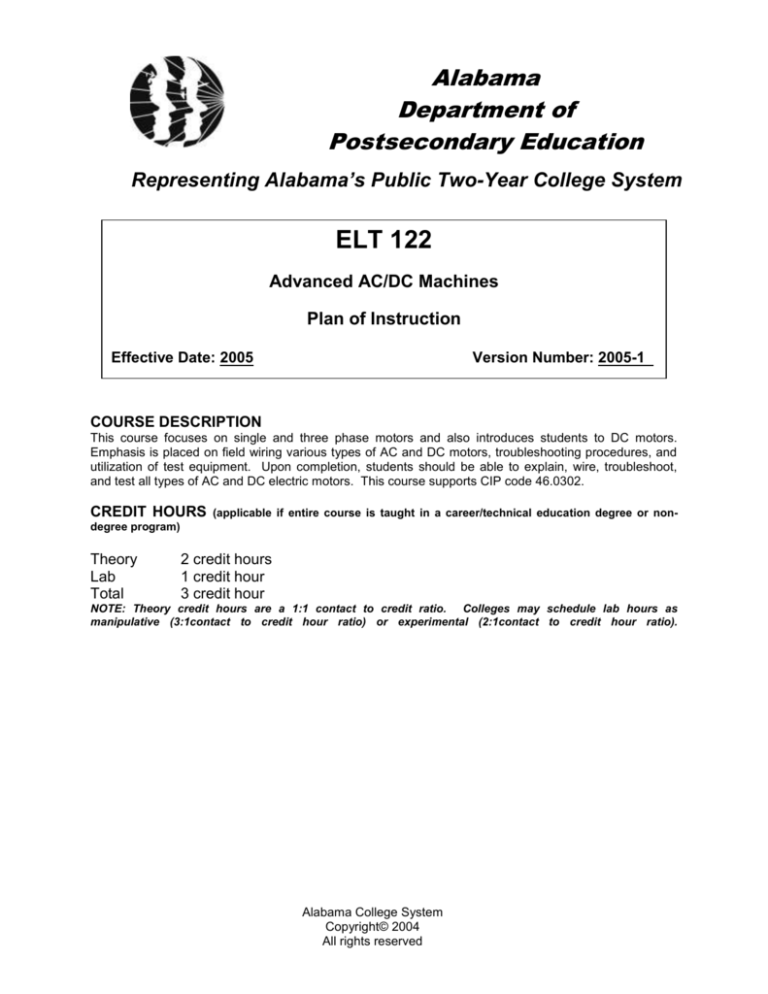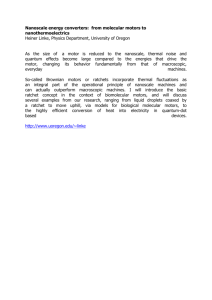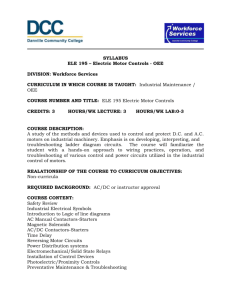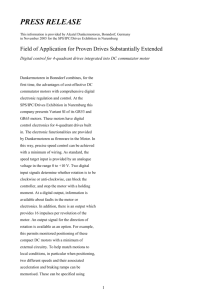
Alabama
Department of
Postsecondary Education
Representing Alabama’s Public Two-Year College System
ELT 122
Advanced AC/DC Machines
Plan of Instruction
Effective Date: 2005
Version Number: 2005-1
COURSE DESCRIPTION
This course focuses on single and three phase motors and also introduces students to DC motors.
Emphasis is placed on field wiring various types of AC and DC motors, troubleshooting procedures, and
utilization of test equipment. Upon completion, students should be able to explain, wire, troubleshoot,
and test all types of AC and DC electric motors. This course supports CIP code 46.0302.
CREDIT HOURS
(applicable if entire course is taught in a career/technical education degree or non-
degree program)
Theory
Lab
Total
2 credit hours
1 credit hour
3 credit hour
NOTE: Theory credit hours are a 1:1 contact to credit ratio. Colleges may schedule lab hours as
manipulative (3:1contact to credit hour ratio) or experimental (2:1contact to credit hour ratio).
Alabama College System
Copyright© 2004
All rights reserved
Advanced AC/DC Machines
ELT 122
PREREQUISITE COURSES
Determined by college unless stated otherwise.
CO-REQUISITE COURSES
Determined by college unless stated otherwise.
INSTRUCTIONAL NOTE: Foundational academic skills in Math such as integers,
percents, ratio and proportions, metric system and linear equations, and Technical
Writing such as research, organization, composition, documentation, and report
presentation are used throughout this discipline.
INDUSTRY/PROFESSIONAL COMPETENCIES:
Explain the principles of single phase motors
Explain the principles of DC motors, generators, and controls
Explain the principles of three-phase generation, motor theory, connection, design
letters and efficiency ratings
Draw connections dual-voltage
Read and interpret wiring diagrams
Use test equipment
Demonstrate lockout/tag out procedures
Calculate overload requirements per NEC 430-32
Calculate branch circuit and conductor
Calculate branch circuit over-current requirements per NEC
Calculate feeder conductor size requirements per NEC
Calculate feeder over-current requirements per NEC
GENERAL INSTRUCTIONAL OBJECTIVES
The cognitive objective for this course is for each student to comprehend foundational
knowledge of single-phase, three-phase motors and generators.
The performance objective of this course is for each student to apply foundational
knowledge of single-phase, three-phase motors and generators in a simulated
environment.
INDUSTRY/PROFESSIONAL COMPETENCIES/STUDENT PERFORMANCE
Unless otherwise indicated, evaluation of student’s attainment of cognitive and
performance objectives is based on knowledge gained from this course. During
performance evaluations, students will be provided necessary tools, equipment,
materials, specifications, and any other resources necessary to accomplish the task.
Specifications may be in the form of, but not limited to, certification agencies, national
and state codes, health care facility policies, locally developed lab/clinical assignments,
or any combination of specifications.
Alabama College System
Copyright© 2004
All rights reserved
2
Advanced AC/DC Machines
ELT 122
MODULE A – SINGLE PHASE AC MOTORS
INDUSTRY/PROFESSIONAL
STUDENT PERFORMANCE OBJECTIVES
COMPETENCIES
A1.0 Explain the principles of
This competency is measured cognitively
single phase motors (3B)
ENABLING OBJECTIVES/KEY INDICATORS
A1.1.1 Identify the winding and parts of a shaded-pole motor
A1.1.2 Identify the windings, switches, and parts of a split-phase motor
A1.1.3 Identify the windings, switches, capacitors, and parts of a capacitor
start run motor
A1.1.4 Identify the windings, commutator, and brush of a repulsion motor
A1.1.5 Identify the windings and parts of a universal motor
A1.1.6 Compare and contrast parts of a universal motor to those of a DC
series motor
KSA
Indicator
a
a
a
a
a
C
MODULE B – DC GENERATORS AND MOTORS
INDUSTRY/PROFESSIONAL
COMPETENCIES
B1.0 Explain the principles of DC
motors, generators, and controls
(3B)
STUDENT PERFORMANCE OBJECTIVES
This competency is measured cognitively
ENABLING OBJECTIVES/KEY INDICATORS
B1.1.1 Identify basic controls for DC generators and motors
KSA
Indicator
a
MODULE C – AC GENERATORS AND MOTORS
INDUSTRY/PROFESSIONAL
STUDENT PERFORMANCE OBJECTIVES
COMPETENCIES
C1.0 Explain the principles of three- This competency is measured cognitively
phase generation, motor theory,
connection, design letters and
efficiency ratings (3B)
KSA
ENABLING OBJECTIVES/KEY INDICATORS
Indicator
C1.1.1 Explain basic electrical generation
A
C1.1.2 Explain basic three-phase motor types
A
C1.1.3 Explain wound rotor motor and synchronous motors
A
C1.1.4 Identify and number wye and delta connections
A
C1.1.5 Calculate efficiency of motors
b
C1.1.6 Identify design code letters per NEC
A
Alabama College System
Copyright© 2004
All rights reserved
3
Advanced AC/DC Machines
ELT 122
MODULE D – DUAL VOLTAGE CONNECTIONS
INDUSTRY/PROFESSIONAL
COMPETENCIES
D1.0 Draw connections for dual
voltage motors (3b)
STUDENT PERFORMANCE OBJECTIVES
D1.1 Draw and show connections for dual-voltage motor
connections
ENABLING OBJECTIVES/KEY INDICATORS
D1.1.1 Explain the principles of dual voltage motor connections
KSA
Indicator
B
MODULE E – WIRING DIAGRAMS
INDUSTRY/PROFESSIONAL
COMPETENCIES
E1.0 Read and interpret wiring
diagrams (3C)
STUDENT PERFORMANCE OBJECTIVES
E1.1 Draw and label wiring diagrams of wye and delta
connections
ENABLING OBJECTIVES/KEY INDICATORS
KSA
Indicator
B
E1.1.1 Explain wiring diagrams of wye and delta motors
MODULE F – TEST EQUIPMENT
INDUSTRY/PROFESSIONAL
COMPETENCIES
F1.0 Use test equipment (3b)
STUDENT PERFORMANCE OBJECTIVES
F1.1 Demonstrate the proper use of a multi meter
F1.2 Demonstrate the proper use of a megger
ENABLING OBJECTIVES/KEY INDICATORS
F1.1.1 Identify a multi meter
F1.1.2 Explain how to use a multi meter
F1.1.3 Explain the purpose of a multi meter
F1.2.1 Identify a megger
F1.2.2 Explain how to use a megger
F1.2.3 Explain the purpose of a megger
Alabama College System
Copyright© 2004
All rights reserved
KSA
Indicator
a
b
A
a
b
A
4
Advanced AC/DC Machines
ELT 122
MODULE G – SAFETY PROCEDURES
INDUSTRY/PROFESSIONAL
COMPETENCIES
G1.0 Demonstrate lockout/tag out
procedures (3b)
STUDENT PERFORMANCE OBJECTIVES
G1.1 Perform lockout/tag out procedures.
ENABLING OBJECTIVES/KEY INDICATORS
G1.1.1 Explain the purpose and importance of following safety procedures
G1.1.2 Explain Lock Out/Tag Out procedures
G1.1.3 Explain the importance of performing machine safety checks of
equipment and accessories
G1.1.4 Explain the importance of practicing tool safety
KSA
Indicator
B
B
B
A
MODULE H – MOTOR CIRCUIT CALCULATIONS
INDUSTRY/PROFESSIONAL
COMPETENCIES
H1.0 Calculate overload protection
requirements per NEC (3b)
STUDENT PERFORMANCE OBJECTIVES
H1.1 Using the NEC, calculate the minimum size
overload required for various sizes of both AC and DC
motors
H2.0 Calculate branch circuit
conductor (3b)
H3.0 Calculate branch circuit overcurrent requirements per NEC (3b)
H1.2 Using the NEC, calculate the maximum size
overload required for various sizes of both AC and DC
motors
H2.1 Using the NEC, calculate the size of branch circuit
conductor load in amps and determine size of wire from
table 310.16
H3.1 Using the NEC, calculate the size of the overcurrent protective devices required for various size and
types of motors in amps.
H3.2 Determine the proper over-current device from
table 240.6
H4.0 Calculate feeder conductor
H4.1 Using the NEC, calculate the size of feeder
size requirements per NEC (3b)
conductor in amps from various motors and determine
size of wire from table 310.16
H5.0 Calculate feeder over-current
H5.1Using the NEC, calculate the size of the overrequirements per NEC (3b)
current device required for multiple motors on a feeder
(single phase and three phase), and determine the
proper over-current device from table 240.6
KSA
ENABLING OBJECTIVES/KEY INDICATORS
Indicator
H1.1.1 Explain the process of calculating the minimum size overload
b
required for various sizes of both AC and DC motors
H1.2.1 Explain the process of calculating the maximum size overload
b
required for various sizes of both AC and DC motors
Alabama College System
Copyright© 2004
All rights reserved
5
Advanced AC/DC Machines
ELT 122
H2.1.1 Explain the process to calculate the size of branch circuit conductor
load in amps and determine size of wire from table 310.16
H3.1.1 Explain the process to calculate the size of the over-current protective
device required for various size and types of motors in amps.
H3.2.1 Explain how to determine the proper over-current protective device
from table 240.6
H4.1.1 Explain the process to calculate the size of feeder conductor in amps
from various motors and determine size of wire from table 310.16
H5.1.1 Explain the process to calculate the size of the over-current device
required for multiple motors on a feeder (single phase and three phase), and
determine the proper over-current device from table 240.6
Alabama College System
Copyright© 2004
All rights reserved
b
b
b
b
b
6
Advanced AC/DC Machines
ELT 122
COURSE CONTENT OUTLINE
MODULE A – Single Phase AC Motors
Shaded pole
Split phase
Capacitor start/run
Repulsion
AC Series
MODULE B – DC Generators and Motors
Series
Shunt
Compound
MODULE C – AC Generators
Single phase
Three phase
MODULE D – Dual Voltage Connections
Single phase
Three phase
MODULE E – Wiring Diagrams
Single phase
Three phase
MODULE F – Test Equipment
Multi meter
Megger
MODULE G – Safety Procedures
Lock-out
Tag-out
MODULE H – Calculations
Full load amps of motor per NEC or nameplate
Over-load
Branch circuit conductors
Branch circuit protections
Alabama College System
Copyright© 2004
All rights reserved
7
Advanced AC/DC Machines
ELT 122
Feeder conductors
Feeder circuit protection
RECOMMENDED METHODS OF EVALUATION: The tables of specifications below
identify the number of cognitive (knowledge) enabling objectives and psychomotor
(performance) objectives per module. Instructors should develop sufficient
numbers of evaluation items to ensure complete coverage of each cognitive
and/or psychomotor objective as identified in each module. For cognitive
objectives, use appropriate written test items based on the complexity indicator for each
objective. For psychomotor objectives, create comprehensive checklist evaluations.
Facts/Nomenclature (A/a):
Multiple Choice, Fill-in, List, Matching, Alternative
Response (true/false or yes/no)
Principles/Procedures (B/b): Multiple Choice, Fill-in, List, Short Answer
Analysis/Operating Principles (C/c): Multiple Choice, Short Answer, Essay
Evaluation/Complete Theory (D/d): Multiple Choice, Short Answer, Essay
ENABLING OBJECTIVES TABLE OF SPECIFICATIONS
Cognitive Domain
Facts/
Nomenclature
Principles/
Procedures
Analysis/
Operating
Principles
Evaluation/
Complete
Theory
Total
Module A
Module B
Total
STUDENT PERFORMANCE OBJECTIVES TABLE OF SPECIFICATIONS
Psychomotor Domain
Limited
Proficiency
(Level 1)
Partially
Proficient
(Level 2)
Proficient
(Level 3)
Highly
Proficient
(Level 4)
Total
Module A
Module B
Total
Alabama College System
Copyright© 2004
All rights reserved
8
Advanced AC/DC Machines
ELT 122
Knowledge, Skills, and Abilities (KSA) Indicators
Performance
Ability
Value
4
Key Word(s)
Highly
Proficient
3
Proficient
2
Knowledge
Knowledge of Skills
1
d
c
Partially
Proficient
Limited
Proficiency
Complete
Theory
Operating
Principles
b
Procedures
a
Nomenclature
D
Evaluation
C
Analysis
B
Principles
A
Facts
Definition
Can do the complete competency quickly and accurately. Can tell or
show others how to do the competency.
Can do all parts of the competency. Needs only a spot check of
completed work
Can do most parts of the competency. Needs help only on hardest
parts.
Can do simple parts of the competency. Needs to be told or shown
how to do most of the competency.
Can predict, isolate, and resolve problems about the competency
Can identify why and when the competency must be done and why
each step is needed.
Can determine step-by-step procedures for doing the competency.
Can name parts, tools, and simple facts about the competency.
Can evaluate conditions and make proper decisions about the
subject.
Can analyze facts and principles and draw conclusions about the
subject.
Can identify relationship of basic facts and state general principles
about the subject.
Can identify basic facts and terms about the subject
Alpha Scale Values - Any item with an upper case letter (A, B, C, D) by itself is taught as general information on a
topic. This information may be related to the competency or encompass multiple competencies. Examples might
include mathematical computations or knowledge of principles such as Ohm’s Law.
A lower case letter indicates a level of ”Knowledge of Skills." Individuals are taught information pertaining to performing
a competency . These may be indicated alone or in conjunction with a numerical scale value. A lower case letter by
itself indicates the individual is not required to perform the task-just know about the task. (example: Can state or
explain procedures for doing a task).
Numerical Scale Values - The numbers reflect the levels the individual will be able to perform a competency. Number
values are always accompanied by lower case letters (i.e. 1a, 2b, 3c...etc.) in order to specify the level of knowledge of
skills associated with the competency.
Example: An individual with a competency with a scale indicator of 3b has received training of knowledge of skills
whereby he or she can determine the correct procedures and perform with limited supervision; only requiring evaluation
of the finished product or procedure.
NOTE: Codes indicate terminal values.
Alabama College System
Copyright© 2004
All rights reserved
9







